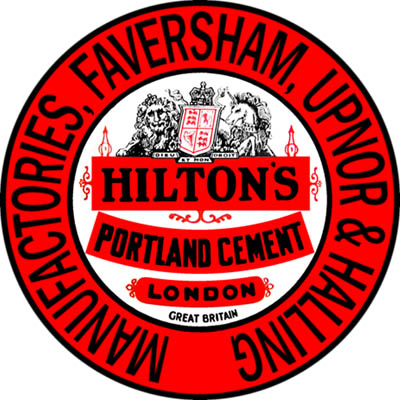
| Pre-1900 Hilton Brand. |

| Post-1900 Hilton Brand. |
Location:
- Grid reference: TQ70636398
- x=570630
- y=163980
- 51°20'57"N; 0°27'1"E
- Civil Parish: Halling, Kent
Clinker manufacture operational: 1878-5/1928
Approximate total clinker production: 1.90 million tonnes
Raw materials: Middle Chalk (Holywell Nodular Chalk Formation: 92-94 Ma), Grey Chalk (Zig-zag Chalk Formation: 94-97 Ma) and Chalk Marl (West Melbury Marly Chalk Formation: 97-100 Ma) by rail from quarry at 569500,164200. After 1906, some gault clay was brought by barge from Burham.
Ownership:
- 1878-1893 Hilton Anderson and Co.
- 1893-1900 Hilton Anderson Brooks and Co. Ltd
- 1900-5/1928 APCM (Blue Circle)
Not to be confused with William Lee's Halling Lime & Cement Works, the Manor plant was from 1900 was designated No.1 Works and No.2 Works, north and south of Ferry Road respectively. Despite its importance, the detailed history of this plant is difficult to elucidate because of the paucity and inaccuracy of the existing accounts. Only two County Edition maps showed the plant in operation, surveyed 1895 and 1907. In particular, all sources say that the plant used Hoffman kilns, and no map shows anything like a Hoffman kiln. The quarry was started to supply the Hilton Anderson plants at Faversham and Upnor. A bank of lime kilns was the first installation at the site in 1873. Cement making started in 1878 with wet process bottle kilns. The map suggests an initial eight 18 ft kilns, and two further sets of 5. By the 1895 map, the latter two sets appear to have been converted to chamber kilns. By the 1907 map, a large extension of the plant had taken place. The old kilns had been consolidated into a bank of twelve 18 ft chamber kilns, and two blocks of three 20 ft chamber kilns had been added. To the south of the lime kilns, two further blocks of nine 18 ft chamber kilns had been added, with what looks like a block of four Schneider kilns for burning surplus dryings. However, before WWI, the plant had been converted entirely to Schneider kiln production, using the set of fifteen kilns shown in the picture, located at 570633,164072, and it is likely that these came into production in 1906, at which time the older kilns were mothballed. In 1924, the Schneider kilns were rated at 2000 t/week, 4.97 MJ/kg. The plant was described in detail in the APCM 1924 schedule. The plant had 400 m of wharf on the Medway, but also had a siding on the North Kent line of the South Eastern railway well before the turn of the century, allowing more transportation flexibility than many of the other Medway plants. The site, with Lee’s could conceivably have been developed into a more modern plant, but the construction of Holborough in 1924 constrained its reserves, and it closed as new capacity on the Thames was brought on line. After closure, the site was cleared, and is now largely residential, although some foundations are still visible in a small patch of waste ground south-east of the parish church. The quarries are waste land. To resolve the difficulties in its history, pictures and plans of this plant are urgently sought - please contact me with these.
Power supply
The plant was initially direct-driven by steam, with separate engines for raw- and finish-milling. With the change to Schneider kiln production, one 300 HP double expansion steam engine was retained for dry raw milling, and the finish mills continued to be driven by two 300 HP double expansion steam engines. In addition, a 300 HP gas engine was supplied for the drying plant, and a total of 470 kW of gas-engine-driven electric generation was used for kiln fans, conveyors and washmills.
Rawmills
The arrangements for the earlier plant are unknown, but washmills were used. Around 1906, a dry process plant was installed for the Schneider kilns. Part of the chalk was washed to slurry. Crushed chalk and clay were fed to two 12'6" pan mills, the product then crushed and fed to three rotary driers followed by eight Roulette mills. The resulting raw meal was stored and corrected in six 250 t bins and fed with some slurry to wetting mixers and four briquetting presses.
No rotary kilns were installed.
Sources:
- Primary Sources:
- Greenhithe Archive
- APCM 1924 schedule
- photographs
- Ordnance Survey 1:2500 mapping
- BGS mapping and monographs
- Confirmatory Sources: